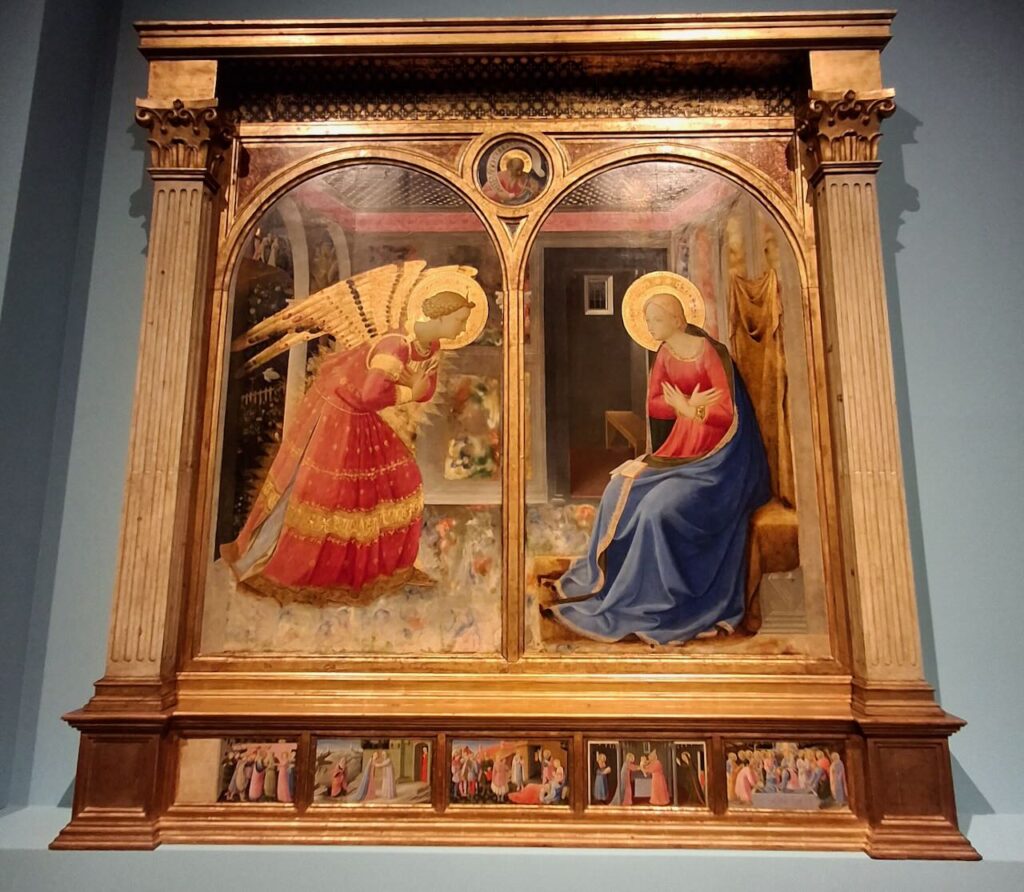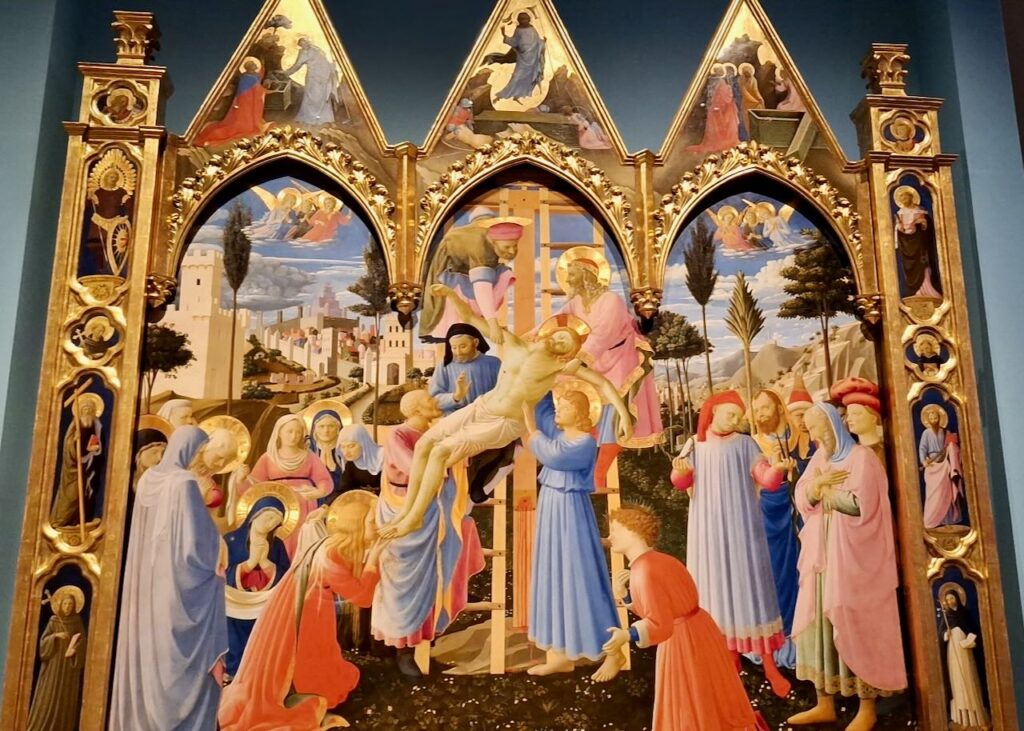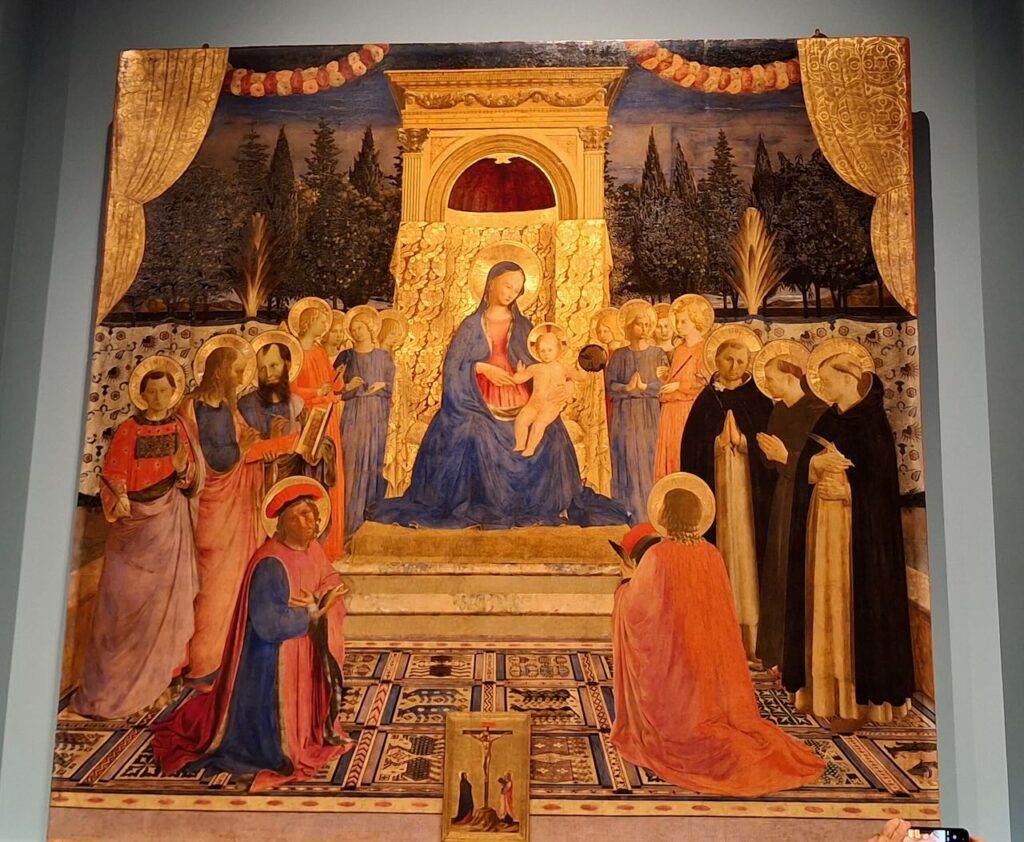Rich golden halos, angels wings and Madonnas draped in blue. These are the images that stayed with me once I left the Beato Angelico exhibition in Palazzo Strozzi, Florence. It’s a magnificent and moving collection of artworks that shows us just why he was called an ‘angelic painter’.
Beato Angelico Exhibition in Florence: from 26th September 2025 to 25th January 2026.
Beato Angelico Exhibit at Palazzo Strozzi, Florence
The exhibits brings together over a hundred artworks that are scattered around the world, and shows various aspects of his art. Commissions by famous Florentine families – including the Medici – his relationship with some contemporary artists (like Lorenzo Monaco and Masaccio), the works in important churches in Florence, where the new art of the Renaissance was moving its first steps. The exhibit does not follow a chronological order, but it’s organised into themes.
Who was Beato Angelico? Friar and Artist of the Renaissance
Who was Beato Angelico? Dominican friar, born in Vicchio (not far from Florence) in 1395, he’s considered one of the highest examples of ‘christian religious art’. He worked extensively in Florence, and in the last years in Rome (working for the Pope), where he’s buried. He’s an important artist of Early Renaissance.
Now we go back to the start of the Renaissance. While young Masaccio was trying out perspective and bringing realism into his artworks (in Florence you can see the results in the Church of Santa Maria Novella and the Brancacci Chapel in Santa Maria del Carmine Church), Beato Angelico was also following this new trend, using more lifelike details in his paintings. He mixes old and new techniques perfectly : on one side the late Gothic taste – that uses golden backgrounds to represent God-the inspired mystical light – and the modern use of perspective when designing a space or giving volume to his figures.
His creations are a mix of deep religious mysticism and modern artistic experimentation. All infused with his special touch of grace and sensitivity. Fra’ Angelico is an artist, but also a deeply devout man, who tries to convey his religious feeling in his paintings.
* See the Top Frescoes in Florence, including frescoes by Masaccio and Beato Angelico.

His Altarpieces – Religious Fervour and Artistic Experimentation
As an example of daring experimentation, look at the way the floor has been painted in this ‘Annunciation’ (see picture above). The colours form an almost ‘abstract’ surface on which the figures stand out.
The exhibit starts with the Pala Strozzi altarpiece, commissioned by the Strozzi family first to Lorenzo Monaco and finished by Fra’ Angelico – a great altarpiece full of extraordinary colour and religious fervour, featuring the city of Jerusalem in the background. It was originally in the Santa Trinita Church in Florence.

A collection of altarpieces allow us to see how the two sides of the artist emerge, the new and the traditional, and his most distinctive traits: graceful Madonnas, angels with multicoloured wings, and vivid details.
In the San Marco altarpiece – one of his most impressive – notice the Persian rug in the foreground, with its complex design. Here the friar follows the example of the Flemish master Jan van Eyck. Even the background with the trees was an original element, and many artists took inspiration from it.

One room is dedicated to majestic wooden crucifixes, and representations of Christ, from which emerge the impressive ‘Cristo re dei re’ with blood stains on the holy face and the colour red to symbolise passion being used with a dramatic effect.
Beato Angelico Representing Heaven and Hell
I was struck by the ‘Last Judgment and Paradise’ in the last room. The audio-guide explains that all the beautiful details are the result of the friar’s profound theological knowledge. For instance the empty tombs follow a spectacular (and very modern) perspective, and the distribution of the figures is a complex representation of Paradise and Hell, filled with references from learned doctrines.
The divine light shines in the gold-infused paintings of Beato Angelico, leaving us with a glorious sensation that is at once spiritual and full of hope.
Why is Fra’ Angelico called ‘Beato’, or Blesses?
Vasari called him ‘Beato’ (blessed) first, referring to his religious-inspired art, while in 1982, the Pope beatified him, formally recognising him as ‘Blessed’.
Beato Angelico was given a monumental burial place in Rome. The inscription on his tomb reads: ‘I should not be praised because I was like another Apelles, but because I gave all my work to you, Christ’.
The exhibit ‘Beato Angelico’ currently underway in Florence in two venues, San Marco Museum and Palazzo Strozzi. From September 2025 until January 2026. To delve into the world of the friar painter you must also visit San Marco Museum and see the famous wonderful frescoes: the crucifixion, the annunciation and the frescoed friars’ cells.
See what Ruskin wrote on Angelico
* Unusual, Quirky Museums in Florence and Where to Find Them
* 8 Famous Statues in Florence You Must See
* Most Famous Renaissance Masterpieces in Florence
Author: Sabrina Nesi, co-founder of Lovefromtuscany.com, passionate about sharing the beauty of Tuscany and Italy with the world.
Disclaimer: some links to tours and services on this site will earn us affiliate commission, at no extra cost to you. The small commission we earn help us keeping the site going, thanks for reading! 🙂

